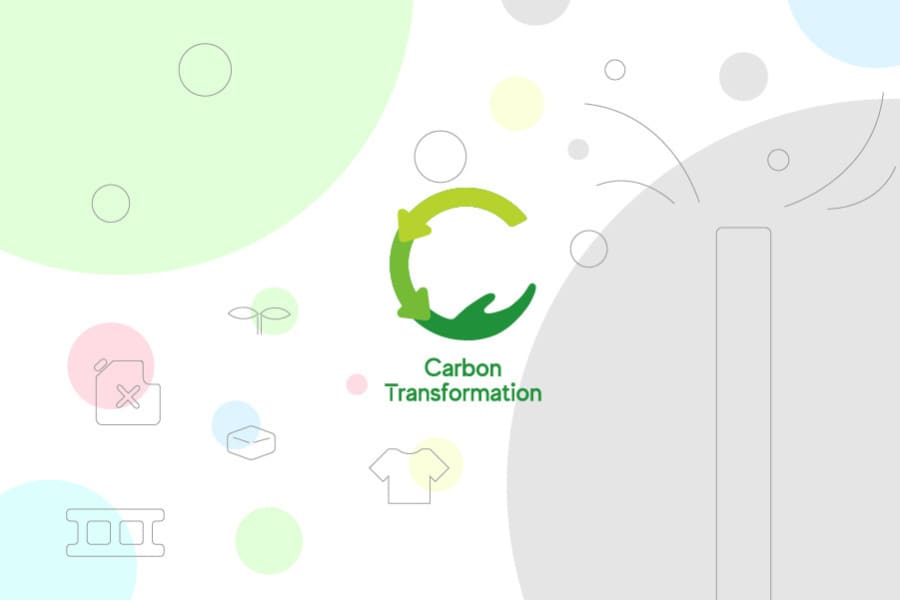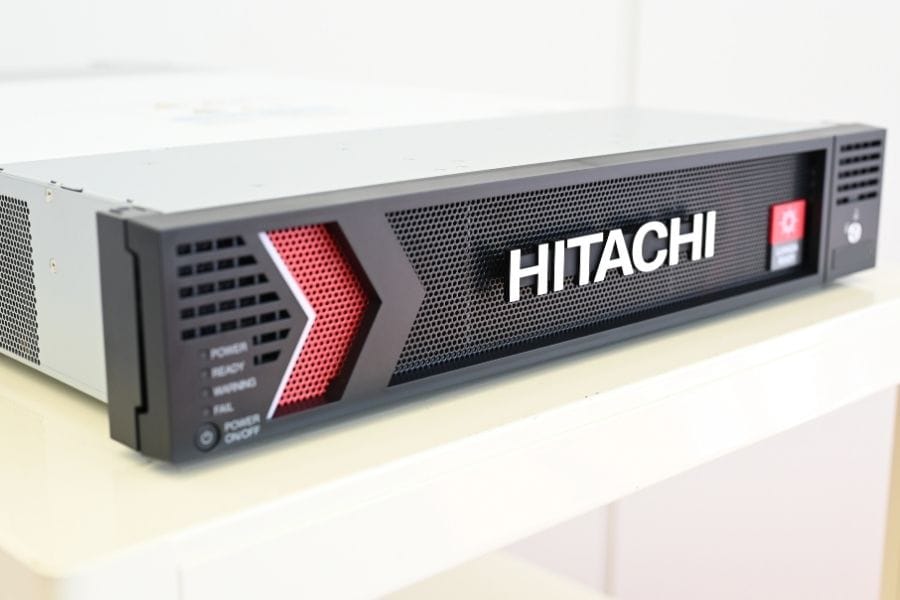Hitachi has unveiled the next generation of the OASIS™
AI Presenting Decarbonized Future Scenarios: For Use in Policymaking
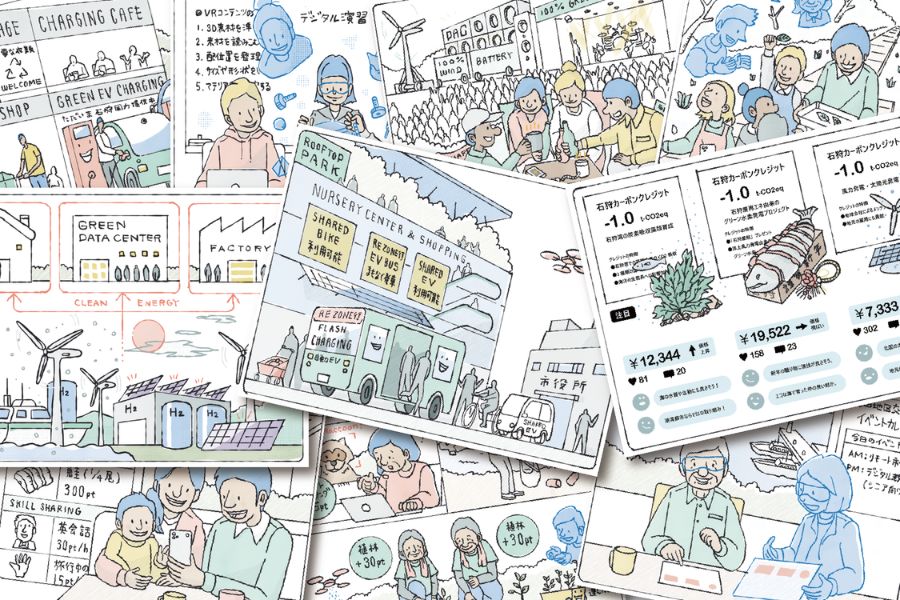
In response to heat waves, torrential rains, and worsening global warming, the Japanese government set a goal in October 2020 to achieve "carbon neutrality"—the reduction of greenhouse gas emissions to essentially zero—by 2050. Prefectures and municipalities around Japan are also declaring themselves as "Zero Carbon Cities," representing their work to achieve 2050 carbon neutrality.
However, some of these local municipalities are struggling to evaluate the types of policies and the timing of their implementation with a view toward decarbonization. This is because of the difficulty in envisioning details of a future 30 years from now and designing a concrete roadmap that leads to it.
To assist these municipalities, Hitachi, Ltd. has developed an AI-based "Decarbonization scenario simulator." With the help of AI, local governments have started trials in which they consider long-term roadmaps toward decarbonization.
What is the decarbonization scenario simulator?
With temperatures exceeding 40°C, Japan's 2022 summer was a hot one. In Ishikari City in Hokkaido, about 15 city officials, mainly younger people, from the Environment Department, Promoting Partnership Department, and Finance Department, and other bureaus gathered to hold a workshop for discussing the future of Ishikari City.
In 2020, Ishikari City declared itself a Zero Carbon City. However, the people in charge were troubled by the fact that it was unacceptable to enact CO2 reduction policies at the expense of the city's economic development and livability. The challenge was to somehow enable decarbonization that coexisted with economic, social welfare, and other realities.
This is where the Decarbonization scenario simulator developed by Hitachi played a crucial role. Based on various indexes, the simulator uses AI to come up with tens of thousands of futures and scenarios leading to those futures, that is, "future scenarios."
Out of these tens of thousands of possibilities, the simulator also collectively derives similar future scenarios. Those in charge then look through several of these to find the ideal approach to achieving decarbonization for their government.
Yukiko Morimoto, who is a senior researcher at Hitachi and the developer of the simulator, emphasized the significance, saying that "The number of futures that people can think of is limited to two or three at most. The simulator, however, will show a vast range of possibilities."
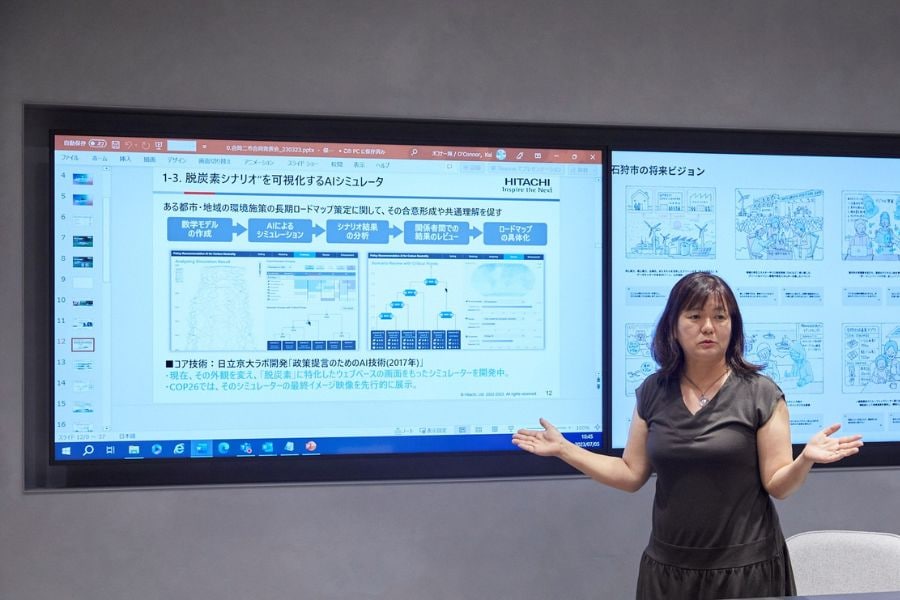
Considerations of indexes and causal relationships
The simulator needs the input of specific regional information to improve its performance: This information comprises indexes and causal relationships.
Mr. Muneo Tokizaki, Manager of Ishikari City's Environment Department and a workshop participant, presented the following example of Ishikari City indexes and causal relationships:
"Ishikari City receives a large winter snowfall, so clearing snow from roads is essential. Without accessible roads, city life comes to a standstill. The problem is that the operation of snow-removing heavy machinery produces CO2 emissions."
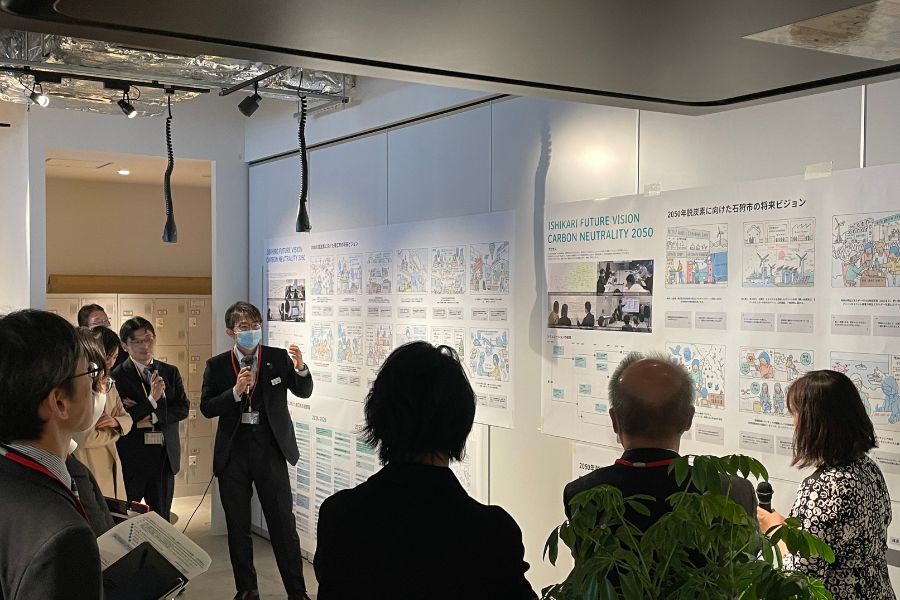
The "snow" index has a causal relationship with the "traffic" index: snow works negatively on traffic. The use of "fossil fuel," the index for the fuel of heavy machinery, has a negative impact on the "decarbonization" index. In connection with the "fossil fuel" index, Mr. Tokizaki also explained: "If the energy used at the Ishikari Bay New Port Area, an industrial park in the bay area, is switched from fossil fuels to renewable energy, this will work positively on decarbonization."
At the workshop, the city officials considered the types of indexes that would be associated with the seven sectors of population, finance, city infrastructure, education, industry, health and welfare, and environment. After coming up with about 300, they organized them into causal relationships based on traffic, financial, and other information accumulated by the city up to the present.
Other indexes, such as "local patriotism," were problematic in considering how they would be affected. To deal with this, causal relationships were determined based on the results of past city resident questionnaires conducted by the city.
Pinning down the future through discussion
After creating a causal relationship model that brought together the various indexes and causal relationships, the workshop input the model into the simulator's AI. Used was an ordinary notebook computer on which the simulator was installed. About 20,000 results were produced in about one to two hours.
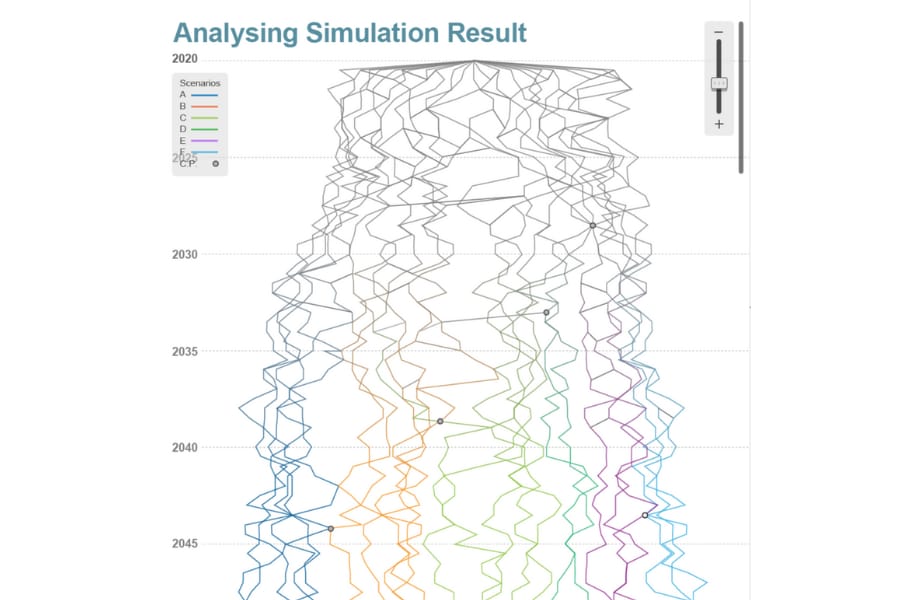
The simulator then used AI to further analyze the results, compiling about 20 future scenarios. To facilitate discussion at the workshop, similar future scenarios were amalgamated and further organized into eight scenarios: A to H.
Approaching from various angles, the city officials discussed the merits and demerits of these eight future scenarios.
Morimoto said that "We asked the participants to think of themselves as data scientists and interpret why such results were generated. Because unforeseen future scenarios were also produced, initially they may have been puzzled."
According to Mr. Tokizaki: "Each bureau person-in-charge had his/her own individual take, such as "increasing tax revenues is better" or "promoting the revitalization of the Ishikari Bay New Port Area is best."
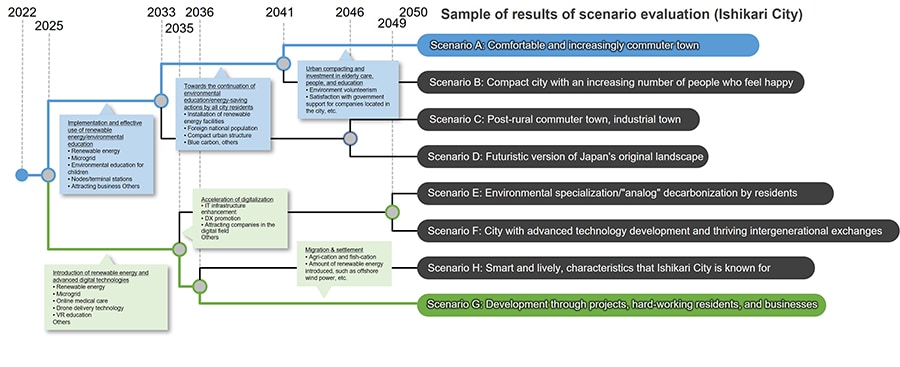
Society cannot be sustained solely on achieving decarbonization, so each official had opportunities to give their opinion during the discussions about which future scenario to select. Some future scenarios featured population and welfare improvements to society. Others contributed to the environment or economic development. Scenarios that balanced all factors and scenarios that contributed to the environment despite some negative points were highly evaluated, leaving Scenario A and Scenario G.
Scenario A: Features urban development in alignment with current policy and achieves high satisfaction from city residents while working toward decarbonization
Scenario G: Local companies making efforts leading to decarbonization with, conversely, the population decreasing
"Scenario A is an all-around type. It maintained an awareness of the development of the Ishikari Bay New Port Area while bringing together positive indexes that took a broad view of municipal government, such as city greening, population, education, and welfare. In the end, we chose the good balance."
Looking back, Mr. Tokizaki said:
"Alternatively, Scenario G would promote city development through new enterprises such as a small-scale power network called a ‘microgrid( and renewable energy. In other words, it is a policy that leans toward the development of the Ishikari Bay New Port Area. Despite having leverage, though, if things do not go well, it might ruin the city."
In the end, Scenario A was selected by a majority decision. In addition to environmental protection, the scenario’s favorable balance received wide support for its focus on improving the well-being of city residents through such factors as education and welfare.
Working with AI
At the workshop, the timing of the implementation of the policies required for decarbonization and city development was considered in units of years. This was made possible by the simulator showing not only the future but also any branches up that point.
The simulator showed that, in the progression to Scenario A's future, there is a large branch in 2025. What must be done by 2025? Would this lean positive or negative? The workshop participants responded by applying concrete policies while observing fluctuations in the values of each index.
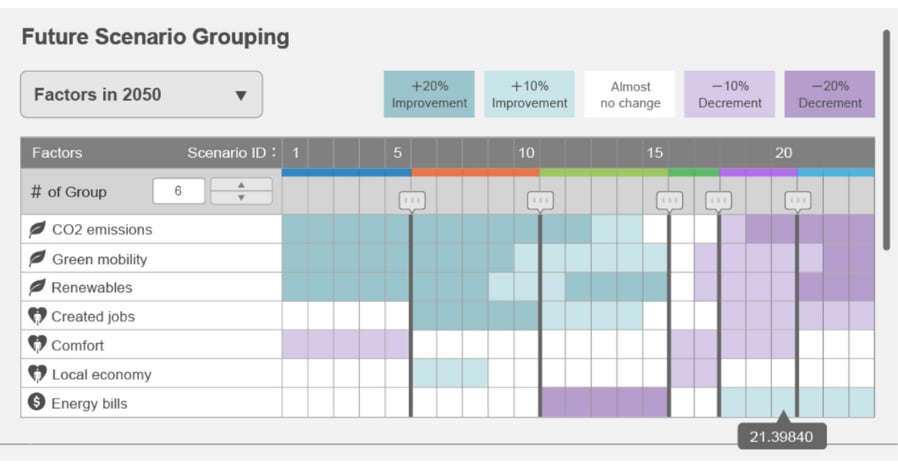
All this led to the development by Ishikari City of "Roadmap to 2025," which spells out the policies aligned with Scenario A. Looking back, Mr. Tokizaki said:
"AI shows us future scenarios that human intellect by itself cannot conceive. Its potential is encouraging. At the same time, the futures presented were also the result of the consolidation of the ideas and wisdom of the city officials who discussed indexes and causal relationships. In the end, because all the officials together selected the future scenario, their takeaway was that 'we created this!'"
In the process of creating the roadmap, opinions were expressed about the necessity for Ishikari City to focus more on the environmental education of children. To begin with, a budget was allocated for broadly communicating the importance of decarbonization to the next generation for modifying city resident behavior.
Toward a society where everybody can talk about future scenarios
There is no single way to achieve the decarbonized society. There are several routes. The decarbonization scenario simulator shows these multiple options.
Morimoto witnessed at the workshop how identifying what routes exist was a factor in deepening discussions on specific policies. Concerning future prospects, she said:

"It would be wonderful if we could make it possible for all city residents to have the ability to use the simulator without our consulting support. Our aim is a world where everybody can talk about future scenarios."

